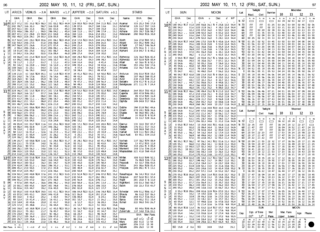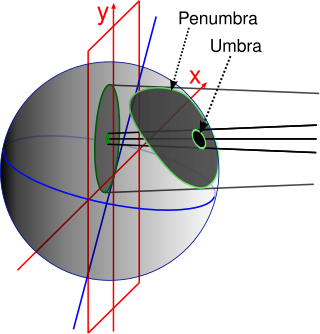Related Research Articles

In precise timekeeping, ΔT is a measure of the cumulative effect of the departure of the Earth's rotation period from the fixed-length day of International Atomic Time. Formally, ΔT is the time difference ΔT = TT − UT between Universal Time and Terrestrial Time. The value of ΔT for the start of 1902 was approximately zero; for 2002 it was about 64 seconds. So Earth's rotations over that century took about 64 seconds longer than would be required for days of atomic time. As well as this long-term drift in the length of the day there are short-term fluctuations in the length of day which are dealt with separately.

The ecliptic or ecliptic plane is the orbital plane of the Earth around the Sun. From the perspective of an observer on Earth, the Sun's movement around the celestial sphere over the course of a year traces out a path along the ecliptic against the background of stars. The ecliptic is an important reference plane and is the basis of the ecliptic coordinate system.
The term ephemeris time can in principle refer to time in association with any ephemeris. In practice it has been used more specifically to refer to:
- a former standard astronomical time scale adopted in 1952 by the IAU, and superseded during the 1970s. This time scale was proposed in 1948, to overcome the disadvantages of irregularly fluctuating mean solar time. The intent was to define a uniform time based on Newtonian theory. Ephemeris time was a first application of the concept of a dynamical time scale, in which the time and time scale are defined implicitly, inferred from the observed position of an astronomical object via the dynamical theory of its motion.
- a modern relativistic coordinate time scale, implemented by the JPL ephemeris time argument Teph, in a series of numerically integrated Development Ephemerides. Among them is the DE405 ephemeris in widespread current use. The time scale represented by Teph is closely related to, but distinct from, the TCB time scale currently adopted as a standard by the IAU.

In astronomy, the new moon is the first lunar phase, when the Moon and Sun have the same ecliptic longitude. At this phase, the lunar disk is not visible to the naked eye, except when it is silhouetted against the Sun during a solar eclipse.
The Julian day is the continuous count of days since the beginning of the Julian period, and is used primarily by astronomers, and in software for easily calculating elapsed days between two events.

Nevil Maskelyne was the fifth British Astronomer Royal. He held the office from 1765 to 1811. He was the first person to scientifically measure the mass of the planet Earth. He created the British Nautical Almanac and Astronomical Ephemeris for the Meridian of the Royal Observatory at Greenwich using Johann Tobias Mayer's corrections for Euler's Lunar Theory tables.

The equatorial coordinate system is a celestial coordinate system widely used to specify the positions of celestial objects. It may be implemented in spherical or rectangular coordinates, both defined by an origin at the centre of Earth, a fundamental plane consisting of the projection of Earth's equator onto the celestial sphere, a primary direction towards the vernal equinox, and a right-handed convention.
In astronomy and celestial navigation, an ephemeris is a book with tables that gives the trajectory of naturally occurring astronomical objects as well as artificial satellites in the sky, i.e., the position over time. Historically, positions were given as printed tables of values, given at regular intervals of date and time. The calculation of these tables was one of the first applications of mechanical computers. Modern ephemerides are often provided in electronic form. However, printed ephemerides are still produced, as they are useful when computational devices are not available.
An almanac is an annual publication listing a set of current information about one or multiple subjects. It includes information like weather forecasts, farmers' planting dates, tide tables, and other tabular data often arranged according to the calendar. Celestial figures and various statistics are found in almanacs, such as the rising and setting times of the Sun and Moon, dates of eclipses, hours of high and low tides, and religious festivals. The set of events noted in an almanac may be tailored for a specific group of readers, such as farmers, sailors, or astronomers.
Newcomb's Tables of the Sun is a work by the American astronomer and mathematician Simon Newcomb, published in volume VI of the serial publication Astronomical Papers Prepared for the Use of the American Ephemeris and Nautical Almanac. The work contains Newcomb's mathematical development of the position of the Earth in the Solar System, which is constructed from classical celestial mechanics as well as centuries of astronomical measurements. The bulk of the work, however, is a collection of tabulated precomputed values that provide the position of the sun at any point in time.

A nautical almanac is a publication describing the positions of a selection of celestial bodies for the purpose of enabling navigators to use celestial navigation to determine the position of their ship while at sea. The Almanac specifies for each whole hour of the year the position on the Earth's surface at which the Sun, Moon, planets, and First Point of Aries is directly overhead. The positions of 57 selected stars are specified relative to the First Point of Aries.
The apparent place of an object is its position in space as seen by an observer. Because of physical and geometrical effects it may differ from the "true" or "geometric" position.

In celestial navigation, lunar distance is the angular distance between the Moon and another celestial body. The lunar distances method uses this angle, also called a lunar, and a nautical almanac to calculate Greenwich time if so desired, or by extension any other time. That calculated time can be used in solving a spherical triangle. The theory was first published by Johannes Werner in 1524, before the necessary almanacs had been published. A fuller method was published in 1763 and used until about 1850 when it was superseded by the marine chronometer. A similar method uses the positions of the Galilean moons of Jupiter.
The Astronomical Almanac is an almanac published by the United States Naval Observatory (USNO) and His Majesty's Nautical Almanac Office (HMNAO); it also includes data supplied by many scientists from around the world. It is considered a worldwide resource for fundamental astronomical data, often being the first publication to incorporate new International Astronomical Union resolutions. The almanac largely contains Solar System ephemeris and catalogs of selected stellar and extragalactic objects. The material appears in sections, each section addressing a specific astronomical category. The book also includes references to the material, explanations, and examples. It is available one year in advance of its date.

The history of longitude describes the centuries-long effort by astronomers, cartographers and navigators to discover a means of determining the longitude of any given place on Earth.
The Nautical Almanac has been the familiar name for a series of official British almanacs published under various titles since the first issue of The Nautical Almanac and Astronomical Ephemeris, for 1767: this was the first nautical almanac to contain data dedicated to the convenient determination of longitude at sea. It was originally published from the Royal Greenwich Observatory in England. A detailed account of how the publication was produced in its earliest years has been published by the National Maritime Museum.

The Besselian elements are a set of values used to calculate and predict the local circumstances of occultations for an observer on Earth. This method is particularly used for solar eclipses, but is also applied for occultations of stars or planets by the Moon and transits of Venus or Mercury. In addition, for lunar eclipses a similar method is used, in which the shadow is cast on the Moon instead of the Earth.
A fundamental ephemeris of the Solar System is a model of the objects of the system in space, with all of their positions and motions accurately represented. It is intended to be a high-precision primary reference for prediction and observation of those positions and motions, and which provides a basis for further refinement of the model. It is generally not intended to cover the entire life of the Solar System; usually a short-duration time span, perhaps a few centuries, is represented to high accuracy. Some long ephemerides cover several millennia to medium accuracy.
Raphael's Ephemeris is an ephemeris, or set of tables, used in astrology to determine the position of the Sun, Moon and planets. Raphael was a pseudonym used by the original author of the ephemeris, Robert Cross Smith.
The word "transit" refers to cases where the nearer object appears smaller than the more distant object. Cases where the nearer object appears larger and completely hides the more distant object are known as occultations.
References
- ↑ Hockey, Thomas (2009). The Biographical Encyclopedia of Astronomers. Springer Publishing. ISBN 978-0-387-31022-0 . Retrieved August 22, 2012.
- 1 2 3 P. Kenneth Seidelmann, ed., Explanatory Supplement to the Astronomical Almanac (Mill Valley, California: University Science Books, 1992) 613–615.
- ↑ Explanatory Supplement to the Astronomical Ephemeris and the American Ephemeris and Nautical Almanac , (1961) ('ESAE 1961'), a joint publication of the Nautical Almanac Offices of the UK and USA; esp. sect.1B.